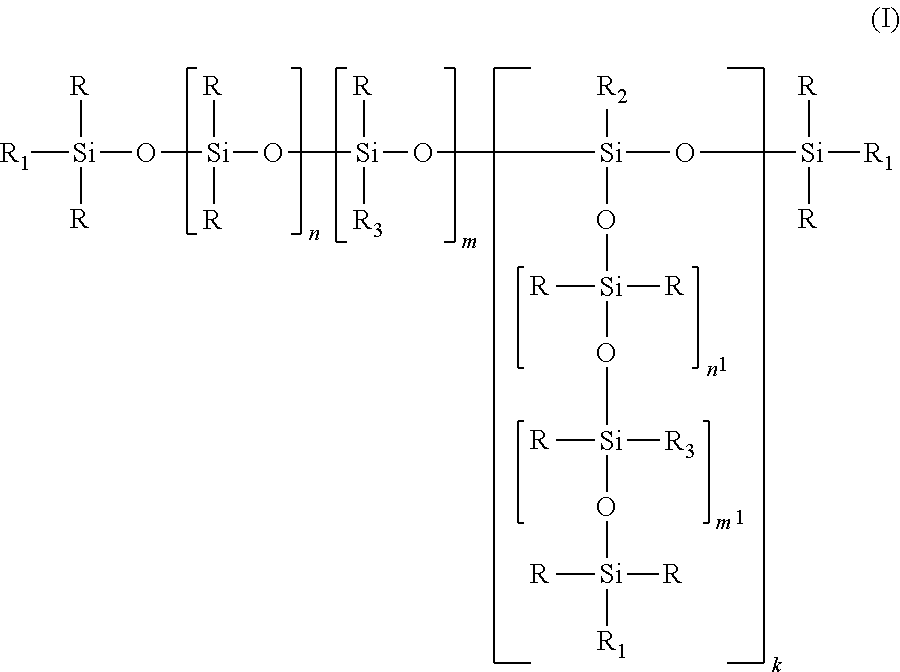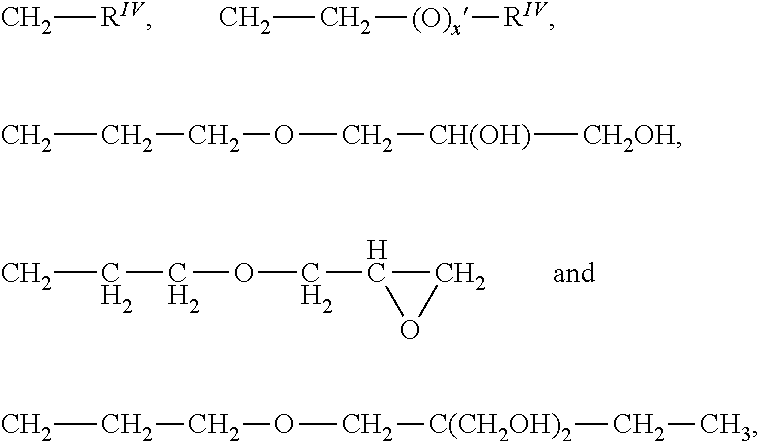Silicone-polyether block copolymers with high molecular weight polyether residues and their use as stabilizers for production of polyurethane foams
a polyether and polyether block technology, applied in the direction of antifouling/underwater paints, biocides, coatings, etc., can solve the problems of poor compatibility between the foam stabilizer and the reacting polyurethane matrix, affecting the homogeneous distribution of the surfactant, and polyethers with molecular weights above 5500 g/mol are not readily available, etc., to achieve good foam stabilization and cell fineness, low use level, and economic production
- Summary
- Abstract
- Description
- Claims
- Application Information
AI Technical Summary
Benefits of technology
Problems solved by technology
Method used
Image
Examples
example 1
Production of Polyether Siloxanes
Example 1a
Production of Polyethers
[0074]The polyethers were obtained using prior art methods known in the art. The molecular weights Mn and Mw were determined by gel permeation chromatography under the following conditions of measurement: column combination SDV 1000 / 10 000 Å (length 65 cm), temperature 30° C., THF as mobile phase, flow rate 1 ml / min, sample concentration 10 g / l, RI detector, evaluation against polypropylene glycol standard.
[0075]The following polyethers of formula (III) each with Q=CH2═CH—CH2— and R′═—CH3 were employed:[0076]PE1: R″═H, z=0, x=16, y=12, Mw=1459 g / mol[0077]PE2: R″═C(O)—CH3, z=0, x=16, y=12, Mw=1484 g / mol[0078]PE3: R″═C(O)—CH3, z=0, x=40, y=30, Mw=3832 g / mol[0079]PE4: R″═H, z=0, x=57, y=60, Mn=5226 g / mol, Mw=6872 g / mol[0080]PE5: R″═CH3, z=0, x=17.7, y=23.6, Mw=2206 g / mol[0081]PE6: R″═CH3, z=0, x=47, y=49, Mw=4983 g / mol[0082]PE7: R″═H, z=0, x=78, y=81, Mn=7032 g / mol, Mw=9871 g / mol[0083]PE8: R″═C(O)—CH3, z=0, x=10, y=16, ...
example 1b
Production of Hydrosiloxanes
[0084]The hydrosiloxanes were obtained as described in Example 1 of EP 1439200 B1. The hydrosiloxanes employed were defined as follows in accordance with formula (II):[0085]SIL1: R4═R═CH3, R5═H, k=0, n=70, m=5[0086]SIL2: R4═R═CH3, R5═H, k=0, n=69, m=8[0087]SIL3: R4═R═CH3, R5═H, k=0, n=89, m=6.5[0088]SIL4: R4═R═CH3, R5═H, k=0, n=74, m=4.0
example 1c
Production of Polyether Siloxanes
[0089]The polyether siloxanes listed in Table 1 and Table 2 were obtained as described in Example 7 of WO 2009 / 065644.
TABLE 1Inventive silicone-polyether block copolymersAppearanceExampleWeights of individualof polyetherNo.SiloxaneAmountpolyethers usedMWblendsiloxane1.1SIL341.0 g11.7 g33.4 g146.1 g3898slightlyPE2PE8PE4g / molcloudy1.2SIL339.0 g11.0 g31.4 g155.2 g4295slightlyPE2PE8PE7g / molcloudy1.3SIL441.0 g127.6 g35.6 g4372slightlyPE7PE1g / molcloudy
TABLE 2Noninventive silicone-polyether block copolymersAppearanceExampleWeights of individualof polyetherNo.SiloxaneAmountpolyethers usedMWblendsiloxaneV.1SIL163.2 g19.2 g62.0 g105.6 g2264clearPE1PE2PE3g / molV.2SIL163.2 g38.3 g42.9 g105.6 g2258clearPE1PE2PE3g / molV.3SIL240.0 g104.3 g138.4 g—3227clearPE5PE6g / molV.4SIL240.0 g132.5 g74.8 g—2761clearPE5PE6g / mol
PUM
| Property | Measurement | Unit |
|---|---|---|
| weight average molecular weight | aaaaa | aaaaa |
| structure | aaaaa | aaaaa |
| molecular weight | aaaaa | aaaaa |
Abstract
Description
Claims
Application Information
 Login to View More
Login to View More - R&D
- Intellectual Property
- Life Sciences
- Materials
- Tech Scout
- Unparalleled Data Quality
- Higher Quality Content
- 60% Fewer Hallucinations
Browse by: Latest US Patents, China's latest patents, Technical Efficacy Thesaurus, Application Domain, Technology Topic, Popular Technical Reports.
© 2025 PatSnap. All rights reserved.Legal|Privacy policy|Modern Slavery Act Transparency Statement|Sitemap|About US| Contact US: help@patsnap.com



